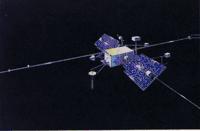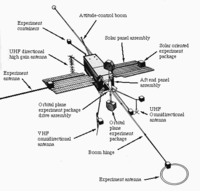Orbiting Geophysical Observatory
Orbiting Geophysical Observatory (OGO) Program [1] of NASA refers to the six satellites launched by the United States that were in use from September 1964 to 1972, designed to study the Earth's magnetosphere.[2] The satellites successfully studied the interactions between the Earth and the Sun, despite a number of technical problems. Each satellite had 20 to 25 instruments. OGO 1, OGO 3, and OGO 5 were in equatorial orbits; OGO 2, OGO 4, and OGO 6 were in lower polar orbits.[3]

Artist's concept of OGO 1

OGO 1 components
OGO launch chronology
- OGO 1 1964-054A NORAD ID: 00879 Launched: 4 September 1964 On-orbit dry mass: 487 kg (still in orbit)[4][5]
- OGO 2 1965-081A NORAD ID: 01620 Launched: 14 October 1965 On-orbit dry mass: 507 kg (decayed 17 September 1981)
- OGO 3 1966-049A NORAD ID: 02195 Launched: 7 June 1966 On-orbit dry mass: 515 kg (decayed 14 September 1981)
- OGO 4 1967-073A NORAD ID: 02895 Launched: 28 July 1967 On-orbit dry mass: 562 kg (decayed 16 August 1972)
- OGO 5 1968-014A NORAD ID: 03138 Launched: 4 March 1968 On-orbit dry mass: 611 kg (decayed 2 July 2011)
- OGO 6 1969-051A NORAD ID: 03986 Launched: 5 June 1969 On-orbit dry mass: 632 kg (decayed 12 October 1979)
Non Earth observations
In 1970 OGO-5 used its ultraviolet photometer to observe Comet Encke.[6]
Notes
- Jackson, J. E. and Vette, J. I. (1975) OGO Program Summary, NASA SP-7601
- "Scientific Satellite Set For Launching". Kentucky New Era. Hopkinsville, KY. Associated Press. September 4, 1964. p. 7. Retrieved December 6, 2010.
- "Orbiting Geophysical Observatory series satellites". NASA HEASARC.
- A. V. Balakrishnan, "Advances in Communication Systems: Theory and Applications" (Academic Press, 2014) p. 264
- "Giant Space Lab Orbited; Fails Tests", Chicago Tribune, September 5, 1964, p. 1
- Sekanina, Z (December 1991). "Encke, the comet". Journal of the Royal Astronomical Society of Canada. 85 (6): 324–376. Retrieved 25 July 2020.
gollark: Our gollariomemes are highly advanced.
gollark: We've been able to assemble Turing machines out of social constructs actually.
gollark: Words don't actually exist.
gollark: We should fix this by using a superior, formally specified, parseable language.
gollark: Doesn't really seem like that?
References
- Hartt, Julian (December 26, 1960). "First 'Streetcar' Satellites To Be Built for NASA". Milwaukee Sentinel. Hearst Headline Service. p. 4M. Retrieved December 6, 2010.
- "Space 'Streetcar'". The Modesto Bee. December 26, 1960. p. A13. Retrieved December 6, 2010.
- "U.S. to Launch Giant Satellite". Spartanburg Herald-Journal. Associated Press. August 30, 1964. p. B8. Retrieved December 6, 2010.
This article is issued from Wikipedia. The text is licensed under Creative Commons - Attribution - Sharealike. Additional terms may apply for the media files.